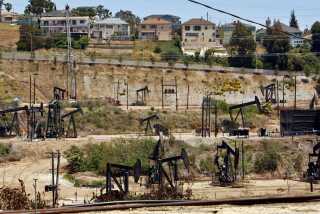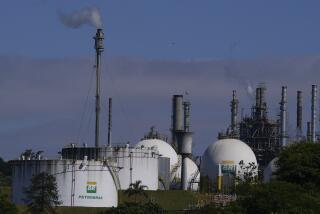A final fix to gulf oil leak may be at hand
Reporting from Atlanta — For more than three months, the world has waited for a permanent fix to the BP oil leak. It may not have to wait much longer.
As early as Sunday evening, the oil giant will take the first steps in a weeks-long process that, though highly complex, has a simple idea at its core: to cram a leaky hole full of cement.
It’s the preferred, time-tested method for taming a wild well, and it is absolutely necessary, experts say. Even though no oil has flowed into the Gulf of Mexico since a sealing cap was installed over the gusher July 15, they say it will take a cement job to shut the well for good.
“The cap is just a temporary solution,” said Peter E. Clark, engineering professor at the University of Alabama. The cap is not bolted to the well, he said, but sealed with a hydraulic ring. “I mean, you couldn’t just walk away from that,” Clark said. “But filling a hole with cement is forever.”
The first step of the “static kill” operation will involve sending dense, specially formulated drilling mud, weighing 13 pounds per gallon — about 1.5 times the weight of a gallon of seawater — from ships down a mile-long drill pipe and eventually into the well through a valve. This will reestablish control over the high-pressure oil and gas that was lost by the operators of the Deepwater Horizon on April 20, sparking a massive explosion that killed 11 workers and sent the drilling rig to the seafloor days later.
Then, engineers will complete the last delicate inches of the relief well they have been boring since early May, trying to intersect the original well bore. That intersection point is roughly 18,000 feet below the gulf surface, and engineers expect to break into the original well around Aug. 10.
For the first time in a disaster that has spanned more than three months, the operative question appears to be when, not if, and the method won’t be experimental, but proven.
“Ultimately they’re going to intersect that pipe down there,” said Thad Allen, the federal government’s spill response chief, in a news conference this week. “This has been done before. Again, it’s not novel technology.”
Clark said the odds of success are “close to 100%.”
In August, a drilling rig in Australian waters suffered a blowout similar to the one that sank the Deepwater Horizon off the coast of Louisiana. Crews tried and failed four times to intersect the Australian well, about 1.6 miles below the seabed. They started Oct. 6, and succeeded on the fifth try, in early November.
In the gulf, precision will be key: The casing pipe engineers are aiming for is only 7 inches in diameter.
The static kill from atop the well head has been described as a value-added complement to the relief well effort. It may give BP a sense of whether, and where, casings are cracked, Allen said.
During the failed top kill operation two months ago, the mud was muscled into the hole with a 30,000-horsepower pump, but it could not overcome the intense pressure of the oil and gas.
“Today, we have the well shut in; we don’t have that flow we have to overcome,” BP Senior Vice President Kent Wells said recently. “So we can go at very slow rates, [with] very little additional pressure above what the well shut-in pressure already is.”
Wells said the company may even be able to add a cement seal at the bottom of the well, after the mud. Even then, an operation to plug the well from underneath, called a “bottom kill,” will be necessary, he said. That’s because the static kill can only tamp down the oil inside the well’s riser pipes. Oil may have seeped into the area between the outside of the pipes and the hole drilled by the original crew, a space called the annulus.
After a series of precision measurements, the relief well’s drill bit will approach the original well at an angle, first chewing into the annulus, allowing workers to fill it with mud and cement. Then, if the static kill hasn’t totally succeeded, they will drill into the casing and fill the well’s interior, too.
The process, Wells, said, could take “anywhere from a number of days to a few weeks, depending upon whether the flow is up the annulus, the casing, or both.”
The government has insisted that BP devise a number of backup plans. A second relief well is being drilled nearby, in case something goes wrong with the first one. Allen said the company could also try diverting the oil to nearby production platforms. If there is some unforeseen complication, some of the oil could again be diverted to large container ships.
Both the Obama administration and BP are expecting — and probably praying for — the cementing plan to work, given the high political and economic stakes.
It’s a sentiment perhaps best reflected in the phrase Allen, a retired Coast Guard admiral, prefers in describing a potential failure.
He calls it “a low probability/high consequence outcome.”
More to Read
Sign up for Essential California
The most important California stories and recommendations in your inbox every morning.
You may occasionally receive promotional content from the Los Angeles Times.










